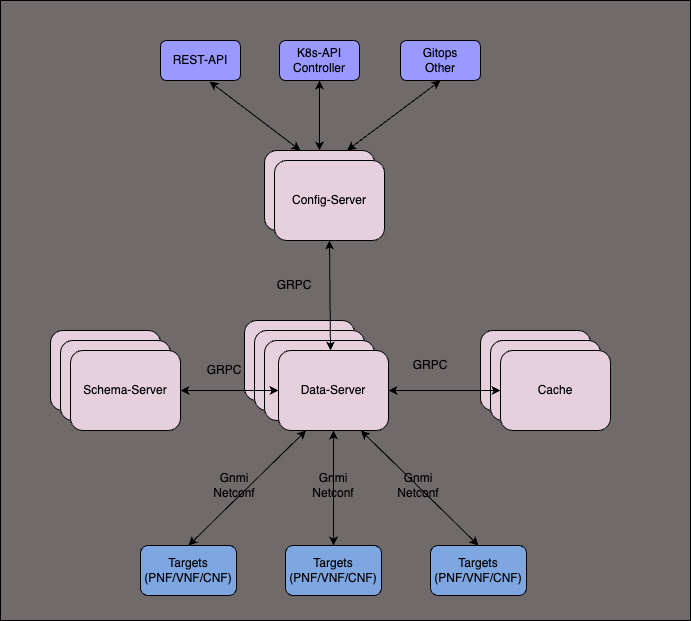Home

The paradigm of schema-driven API approaches is gaining increasing popularity as it facilitates programmatic interaction with systems by both machines and humans. While OpenAPI schema stands out as a widely embraced system, there are other notable schema approaches like YANG, among others. This project endeavors to empower users with a declarative and idempotent method for seamless interaction with API systems, providing a robust foundation for effective system configuration."
Architecture#
The project consists of 4 components:

Schema-server#
The schema server component is a versatile repository for schemas from diverse vendors and versions. It features a GRPC API for seamless schema querying and dynamic management, allowing users to load and unload schemas in real time. The integration of a CLI enhances user interaction, providing a familiar command-line interface. Operating in a stateless architecture, it offers scalability, while optional schema persistence caters to users requiring persistent storage. In essence, the schema server combines flexibility, efficiency, and user-friendliness for effective schema management in dynamic API environments.
Data-server#
The data-server component serves as a versatile intermediary, connecting the config-server, schema-server, cache, and xNF/Device in a stateless design for scalability. It features a North-bound API for both imperative and declarative interactions and supports various South-bound protocols. With dedicated DataStores per target, flexible synchronization options, candidate-based interactions, and the ability to connect multiple data servers per device, it provides a resilient and adaptable foundation for managing and synchronizing data in dynamic system environments.
Cache#
The cache component manages multiple datastores, including Config, State, and Intended, along with Intent metadata. It offers the option for persistent data storage, complemented by a GRPC API for seamless interaction. Additionally, the cache component provides a derived Command Line Interface (CLI) for user-friendly access and configuration.
Config-server#
The config-server is a Kubernetes-based Operator and comprises of several controllers:
- Schema Controller: Manages the lifecycle of schemas using Schema Custom Resources (CR).
- Discovery Controller: Manages the lifecycle of targets through DiscoveryRule CR, discovering devices/NF(s)
- Target Controller: Manages the lifecycle of Target DataStores using Target CR.
- Config API Server: Manages the lifecycle of Config resources.
- Utilizes its storage backend (not etcd).
- Interacts declaratively with the data-server through Intent transactions.
- Implements validation checks, rejecting configurations that fail validation.
Features#
- Schema's: YANG, others TBD
- Targets: Physical devices (
PNF), Containers (CNF), Virtual Machines (VNF) andNOOP(No Operation) - Vendor agnostic
- Flexible deployments: Small, medium or large scale scaled out deployments
- Target Protocols: gNMI, Netconf
- Full Config or Config Snippets
- Declarative Operation
- Deviations (revertive/non revertive)
- Config Blame
Presentations#
Presentations about SDC:
- ONE Summit 2024: Cloud Native YANG Mgmt - Wim Henderickx, Nokia, video
- ContainerDays 2025: The Cloud-Native Advantage: Intent-based Network Automation - Alexander North, Swisscom & Markus Vahlenkamp, Nokia
Join us#
Have questions, ideas, bug reports or just want to chat? Come join our discord channel.
License, Code of Conduct and governance#
The SDC code in the sdcio organisations public repositories is licensed under the Apache License 2.0, documentation is licensed under CC BY 4.0.
The SDC project is following the CNCF Code of Conduct. More information and links about the CNCF Code of Conduct are here.
At the moment, the project is governed by the benevolent dictatorship of @henderiw @steiler @karimra and @hansthienpondt In the long run, we plan to move to a meritocracy-based governance model.